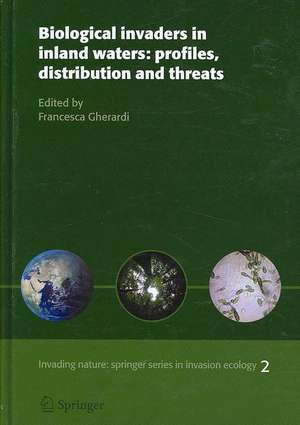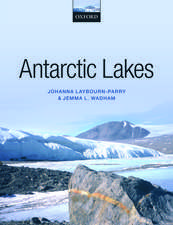Biological invaders in inland waters: Profiles, distribution, and threats: Invading Nature - Springer Series in Invasion Ecology, cartea 2
Editat de Francesca Gherardien Limba Engleză Hardback – 21 aug 2007
The book examines the identity, distribution, and impact of freshwater non-indigenous species and the dynamics of their invasion. Rather than providing a broad and comprehensive review of the issue, Biological invaders in inland waters focuses on old and new invaders and also raises questions and opens perspectives that provide a starting point for further research. The ultimate purpose of this book is to help define a more general framework for our knowledge of invasions in fresh waters. Such a framework will be indispensable to the planning of a science-based management program.
| Toate formatele și edițiile | Preț | Express |
|---|---|---|
| Paperback (1) | 1238.86 lei 43-57 zile | |
| SPRINGER NETHERLANDS – 18 noi 2010 | 1238.86 lei 43-57 zile | |
| Hardback (1) | 1284.03 lei 43-57 zile | |
| SPRINGER NETHERLANDS – 21 aug 2007 | 1284.03 lei 43-57 zile |
Preț: 1284.03 lei
Preț vechi: 1565.90 lei
-18% Nou
Puncte Express: 1926
Preț estimativ în valută:
245.76€ • 253.27$ • 207.48£
245.76€ • 253.27$ • 207.48£
Carte tipărită la comandă
Livrare economică 03-17 martie
Preluare comenzi: 021 569.72.76
Specificații
ISBN-13: 9781402060281
ISBN-10: 1402060289
Pagini: 764
Ilustrații: XXX, 734 p.
Dimensiuni: 160 x 240 x 37 mm
Greutate: 2.35 kg
Ediția:2007
Editura: SPRINGER NETHERLANDS
Colecția Springer
Seria Invading Nature - Springer Series in Invasion Ecology
Locul publicării:Dordrecht, Netherlands
ISBN-10: 1402060289
Pagini: 764
Ilustrații: XXX, 734 p.
Dimensiuni: 160 x 240 x 37 mm
Greutate: 2.35 kg
Ediția:2007
Editura: SPRINGER NETHERLANDS
Colecția Springer
Seria Invading Nature - Springer Series in Invasion Ecology
Locul publicării:Dordrecht, Netherlands
Public țintă
ResearchCuprins
Biological invasions in inland waters: an overview.- Distribution of invaders.- Invasive crustaceans in European inland waters.- Non-indigenous freshwater crabs in France: a new occurrence of a potamid near Nice.- Status and ecosystem interactions of the invasive Louisianan red swamp crayfish Procambarus clarkii in East Africa.- Non-indigenous freshwater molluscs and their distribution in Italy.- Non-indigenous animal species naturalized in Iberian inland waters.- An overview of the natural history of non-indigenous amphibians and reptiles.- The red-eared slider (Trachemys scripta elegans) in Asia: a review.- Semiaquatic mammals introduced into Italy: case studies in biological invasion.- Invasions by plants in the inland waters and wetlands of Africa.- Non-indigenous aquatic and semiaquatic plant species in France.- Profiles of invaders.- Ecological traits of aquatic NIS invading Austrian fresh waters.- Growth and reproduction of the goldfish Carassius auratus: a case study from Italy.- Epigenetic context in the life history traits of the round goby, Neogobius melanostomus.- Growth and life history traits of introduced pumpkinseed (Lepomis gibbosus) in Europe, and the relevance to its potential invasiveness.- The biological flexibility of the pumpkinseed: a successful colonizer throughout Europe.- Patterns and pathways of invasions.- Marine vs. freshwater invaders: is shipping the key vector for species introductions to Europe?.- Modeling biological invasions of inland waters.- Biomonotony: definition and assessment for macroinvertebrates in European running waters.- Genetics and invasion biology in fresh waters: a pilot study of Procambarus clarkii in Europe.- Do estuaries act as saline bridges to allow invasion of new freshwater systems by non-indigenous fish species?.- Which factors determine non-indigenous fish dispersal? A study of the red piranha in tropical Brazilian lakes.- The relationship between biodiversity and invasibility in central Swedish lakes invaded by Elodea species.- Impacts of invaders.- Measuring the impact of freshwater NIS: what are we missing?.- Invasion of the Baltic Sea basin by the Ponto-Caspian amphipod Pontogammarus robustoides and its ecological impact.- Changes in the aquatic systems of north-eastern Europe after invasion by Gmelinoides fasciatus.- The predatory impact of Dikerogammarus villosus on fish.- Understanding the impact of invasive crayfish.- Predation of invasive crayfish on aquatic vertebrates: the effect of Procambarus clarkii on fish assemblages in Mediterranean temporary streams.- Assessing the trophic ecology of crayfish: a case study of the invasive Procambarus clarkii.- and spread of crayfish (Parastacidae) in Western Australia and their potential to displace indigenous species.- The zebra mussel Dreissena polymorpha: reproduction and competition with the sponge Ephydatia fluvia.- Seasonal effects on the antioxidant response and metal accumulation of Dreissena polymorpha.- Managing invasions.- Towards a European strategy to halt biological invasions in inland waters.- A risk assessment of biological invasions in the inland waterways of Europe: the Northern Invasion Corridor case study.- Logistics of shipboard and dockside testing of ballast water treatment systems in the United States.- Virtues and shortcomings of EU legal provisions for managing NIS: Rana catesbeiana and Trachemys scripta elegans as case studies.- Problems and opportunities managing invasive Bullfrogs: is there any hope?.- Concluding remarks.- A role for scientists.
Recenzii
From the reviews:
"This second volume … focuses on non-indigenous freshwater species. The book includes 39 chapters … by 82 contributors from 18 countries. … I do like the book and can recommend it. It is well written throughout … . References are provided separately for each chapter … which is very useful when photocopying a chapter. The book’s index is very useful, too … . In sum, the book … will have a very interesting read." (Jonathan M. Jeschke, Basic and Applied Ecology, Vol. (10), 2009)
"This second volume … focuses on non-indigenous freshwater species. The book includes 39 chapters … by 82 contributors from 18 countries. … I do like the book and can recommend it. It is well written throughout … . References are provided separately for each chapter … which is very useful when photocopying a chapter. The book’s index is very useful, too … . In sum, the book … will have a very interesting read." (Jonathan M. Jeschke, Basic and Applied Ecology, Vol. (10), 2009)
Textul de pe ultima copertă
As predicted by Charles Elton in 1958, today invasive species have come to dominate 3% of the Earth’s ice-free surface, constituting one of the most serious ecological and economic threats of the new millennium. In spite of any prevention effort, the number of invasive species is expected to increase in the next years as an inevitable consequence of both the augmented complexity of international trade and the deregulation of national and international markets. New pathways have been opened and the movement of non-indigenous species along them has been facilitated.
Since the 1980s, studies of non-indigenous species have expanded greatly as a reflection of the rise in popularity that the discipline of invasion biology has gained among ecologists. However, the number of published articles is biased towards terrestrial invaders; invasive events occurring in freshwater systems have been most often neglected or analyzed only in a few regional contexts or for a small number of paradigmatic species. Yet freshwater systems, whose value to humankind is obviously priceless, are particularly vulnerable to non-indigenous species as a direct consequence of the intensity with which humans utilize fresh waters for recreation, food sources, and commerce.
The book examines the identity, distribution, and impact of freshwater non-indigenous species and the dynamics of their invasion. Rather than providing a broad and comprehensive review of the issue, Biological invaders in inland waters focuses on old and new invaders and also raises questions and opens perspectives that provide a starting point for further research. The ultimate purpose of this book is to help define a more general framework for our knowledge of invasions in fresh waters. Such a framework will be indispensable to the planning of a science-based management program.
Since the 1980s, studies of non-indigenous species have expanded greatly as a reflection of the rise in popularity that the discipline of invasion biology has gained among ecologists. However, the number of published articles is biased towards terrestrial invaders; invasive events occurring in freshwater systems have been most often neglected or analyzed only in a few regional contexts or for a small number of paradigmatic species. Yet freshwater systems, whose value to humankind is obviously priceless, are particularly vulnerable to non-indigenous species as a direct consequence of the intensity with which humans utilize fresh waters for recreation, food sources, and commerce.
The book examines the identity, distribution, and impact of freshwater non-indigenous species and the dynamics of their invasion. Rather than providing a broad and comprehensive review of the issue, Biological invaders in inland waters focuses on old and new invaders and also raises questions and opens perspectives that provide a starting point for further research. The ultimate purpose of this book is to help define a more general framework for our knowledge of invasions in fresh waters. Such a framework will be indispensable to the planning of a science-based management program.
Caracteristici
First book providing the state of the art of biological invasions in fresh waters Follows an interdisciplinary approach to the issue of biological invasion
























